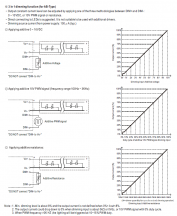Wifi dimming of Mean Well (and compat??) LED drivers
- Thread starter PuffTheMagic
- Start date
PuffTheMagic
Super Active Member
So... with 3 parts on amazon: an esp8266 dev board, a voltage booster and a MOSFET PWM module, it looks like we can have full remote control of our lights on the cheap.
ttystikk
Nerd Gone Vertical
For which drivers? Is this for Meanwell?So... with 3 parts on amazon: an esp8266 dev board, a voltage booster and a MOSFET PWM module, it looks like we can have full remote control of our lights on the cheap.
PuffTheMagic
Super Active Member
Yeah this is for the Meanwell drivers. I've checked the XLG-240 and XLG-75 manuals and the dimming support is the same.
PuffTheMagic
Super Active Member
If it’s an AB driver you just need a 0-10V dimmer module to dim them from whatever platform you want to control it with.
PuffTheMagic
Super Active Member
The only 10v "smart" dimmers I am seeing are wall switch units.If it’s an AB driver you just need a 0-10V dimmer module to dim them from whatever platform you want to control it with.
Some of them have app control like this one https://www.amazon.com/BN-LINK-Smart-Dimmer-Switch-Incandescent/dp/B07KZK36WS/ref=sr_1_13?crid=GWHNCICJMHMM&keywords=0-10v+led+dimmer+wifi&qid=1646316464&sprefix=0-10v+led+dimmer+wifi,aps,68&sr=8-13The only 10v "smart" dimmers I am seeing are wall switch units.
PuffTheMagic
Super Active Member
These are basically what I am recreating here at a fraction of the cost. All of these smart switches uses the same esp8266 chip but you can run a different firmware on them and bypass running everything through some Chinese server halfway around the world.
TerpyTyrone
LED Recruiter
How do I know what the temp is using an app? I understand I can dim from the app but how would I know to dim?
You would need to monitor the temperature somehow. Thats why I personally don't like individual "smart" devices...because most of them need separate apps. It's much more expensive to use an integrated control system but then everything is tied together.How do I know what the temp is using an app? I understand I can dim from the app but how would I know to dim?
PuffTheMagic
Super Active Member
For a few dollars more you can add a temp sensor to this setup.You would need to monitor the temperature somehow.
I hate all the different apps to which is why I reflash all my smart devices with Tasmota and run my own server on one of those $35 Raspberry Pi computers. But, on the note of different apps, the vendors are all about to start using some new standards and everything "should be" inter-compatible right out the box in the short future.Thats why I personally don't like individual "smart" devices...because most of them need separate apps.
Don't get your hopes up. I've been in the integration/automation industry for over 20 years and manufacturers always say they are going to follow standard practices but they never do. All of the TV and video device manufacturers were supposed to follow standard CEC protocol standards starting over 15 years ago but very few of them follow it and come up with their own "CEC" protocols which they rename to their own names "Anynet" is what Samsung calls their CEC control. It's hard enough for them to just provide a clean control protocol or API that is straight forward. Hell, I'm dealing with an alarm panel today that sends a string that starts with a hex byte, ends with a hex byte, but all the data in-between those two bytes are ASCII representations of hex bytes and parsing it is making me want to find who wrote it and smack them upside the head.But, on the note of different apps, the vendors are all about to start using some new standards and everything "should be" inter-compatible right out the box in the short future.
PuffTheMagic
Super Active Member
I'm not holding my breath, but smart devices are so prolific and the multi-app ecosystem drives so many people nuts I can see some fairly positive improvements happening relatively fast.Don't get your hopes up.
That sounds like fun! For my day job, I reverse engineer motorcycle ECUs and then write software to reflash them.Hell, I'm dealing with an alarm panel today that sends a string that starts with a hex byte, ends with a hex byte, but all the data in-between those two bytes are ASCII representations of hex bytes and parsing it is making me want to find who wrote it and smack them upside the head.
Kulla380
Really Active Member
That's why you hide your SSID from othersNeighbor is stealing my wifi and changed the fucking light cycle!




